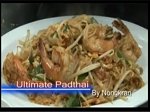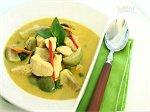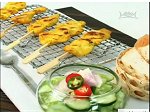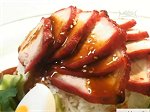|
|
Thai Cooking Ingredients -
Vegetables & Herbs
 |
Lemon Grass (dta kry)
Lemon grass is sold fresh, dried, and pickled. It is often
used in herbal teas. When buying fresh lemon grass, choose
specimens with a firm bulb. Lemon grass has more flavour
fresh than dried. Use it sparingly, particularly if you are
unfamiliar with its taste. Lemon grass goes well with
ginger, chili, coconut, garlic, shallots, and green pepper.
Preparing:
Peel the fresh stems and remove all but the lower 7 cm,
which is the most tender part. The outer layer and upper
portion of the stems are too stringy to be eaten but can be
used to flavour stocks, sauces, soups, stews, fish, poultry,
and herbal tea. Discard them after use. |
 |
Garlic (gkra tium)
Garlic is used in virtually all Thai dishes. The garlic
which is found in Thailand has a stronger flavor than the
western version, but all garlic can be used in Thai cooking.
The garlic found in Thailand has much smaller cloves, so
instead of calling for cloves in recipes, I call by teaspoon
or tablespoon.
Preparing:
To prepare garlic, first smash the clove with the side of
the knife to break the clove somewhat. This will both
release the juice and loosen the paper/skin. Then peel the
skin off, and chop on a cutting board.
For fried garlic (gkratiem jiow) and garlic oil
(nahm man gkratiem), chop the garlic evenly, not
too finely nor too coarsely, or slice into thin ovals, and
fry in hot oil over medium-high heat, stirring frequently to
a uniform golden brown. |
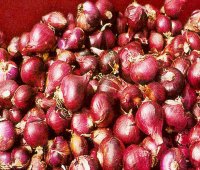 |
Red Shallots (Hawm daeng)
Shallots are used in Thai cooking
almost as much as garlic. The
shallots which are found in Thailand
are smaller than the European
varieties, and are a touch more
flavorful. Preparing:
To prepare shallots, first cut off
the bottom (roots) and then peel off
the paper skin. Slice finely.
Shallots are also fried into
brown crispy pieces to sprinkle on
salads and garnish finished dishes.
Fry thin slices in plenty of oil in
a wok or small pan until they turn
golden brown. Because western
shallots contain more moisture than
Thai red shallots, they should be
fried over low heat for a prolonged
period of time (20 mins or longer)
to allow the slices to dry up before
they brown.
|
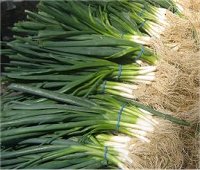 |
Scallions - Spring Onions
(Dton hawm)
These unassuming green onions go under a perplexing variety
of names, including scallions and green shallots. For the
sake of clarity, I call the uniformly skinny ones spring
onions (scallions), while the similar-looking immature
onions with a more pronounced bulb I call salad onions. |
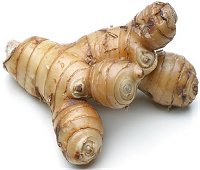 |
Galangal Root (hea-uh kah)
Galangal is the kah in Tom Kah and is also used in Tom Yum
and curry pastes. You cannot substitute ginger for
galangal, or any other root. You can usually find it frozen
in Asian groceries stores. Galangal is recognizable by the
long pink stalks and pink tips on the root.There are two
types of galangal and these are called khaa and krachaai in
Thailand. Fresh galangal tastes the best, you can however
use dried or powdered galangal if fresh galangal is not
available. As a common Thai food ingredient, galangal and
ginger are processed in a similar way. However, the taste
and flavour of ginger and galangal are distinctly different.
Galangal is much harder than ginger and is therefore sliced
into pieces before it is crushed. Delicious Thai curry
pastes use galangal as one of the main ingredients. |
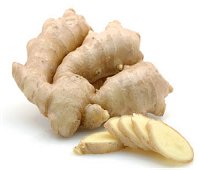 |
Ginger Root (King) |
Young Ginger (King onh)
Young ginger is light in color
and often comes with some green
stem attached. It is often
pickled and eaten with other
food. You've probably seen it
served with sushi - it is the
pink one. It can also be pickled
with other vegetables like
eggplants and cucumber and
served with rice.
The old ginger is used in
various cooking. Often in
Chinese cooking, it is julienne
and tossed in with garlic for
stir fried dishes.
|
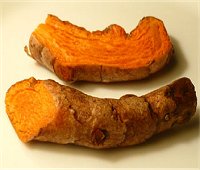 |
Turmeric Root (kha min)
Turmeric root is used for brilliant yellow color
and subtle flavor in Thai curry. It is available frozen or
as a dried ground powder. Substitute one teaspoon dried
turmeric powder for a half-inch fresh piece. |
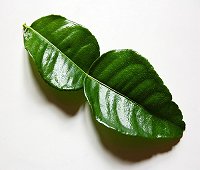 |
Kaffir Lime Leaf (Ma krut)
Is a double, dark green coloured leaf. Kaffir Lime Leaves
are used extensively in Thai cooking. Medicinally Kaffir
Limes are good for the digestion and they have quite a
clean, fresh taste. There's a tanginess without the
bitterness. |
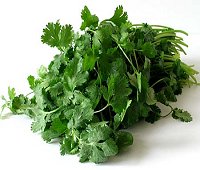 |
Cilantro - Coriander (Pak
chee)
Coriander is known for its medicinal properties. It is said
to be aid digestion and is used to ease rheumatism, joint
pains, colds, and diarrhea. Some people chew the seeds to
neutralize the smell of garlic. Choose fresh coriander that
is firm, crisp, and green. Avoid specimens with yellow,
brown, or wilted leaves, as they are not fresh.Coriander
is considered both an herb and a spice since both its leaves
and its seeds are used as a seasoning condiment.
Preparing
Wash fresh coriander at the last moment, as it is highly
fragile and quickly loses its flavour. Swish it gently in
cool water. |
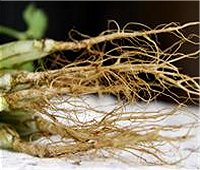 |
Coriander Root (Raag pak
chee)
In Thai cuisine, the root is ground in a mortar and pestle
with garlic and chili and is the basis for many curries,
soups and pastes. |
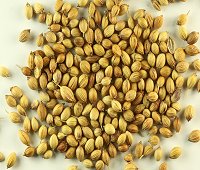 |
Coriander Seeds (Met pak
chee)
The fruit of the coriander plant contains two seeds which,
when dried, are the portions used as the dried spice. When
ripe, the seeds are yellowish-brown in color with
longitudinal ridges. Coriander seeds are available whole or
in ground powder form.
When purchasing corianders buy whole seeds, crushed seeds
loose a lot of their essential vitamins and minerals. When
storing place seed in a wet paper towel and put in a plastic
storage bag and place in refrigerator. |
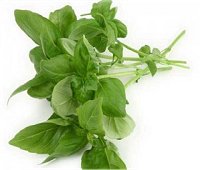 |
Holy Basil (Bai krapow)
Holy basil is sometimes referred to as “hot basil” or
“pepper basil” because unlike sweet or Thai basil, which
have a flavor more reminiscent of licorice, holy basil is
spicy and more like cloves. Because its flavor intensifies
as it cooks, it is preferred cooked over raw. In Thai
cuisine, holy basil is often matched with garlic, hot
chilies, and nam pla (fish sauce) to flavor stir-fries. It
is not interchangeable with Western, or sweet, basil in most
recipes that call for the latter. |
 |
Thai Sweet Basil (Bai
horapha)
Thai basil, also known as Oriental basil or Asian basil, is
a cultivar of sweet basil commonly used in the cuisines of
Thailand, Vietnam, Cambodia, and Laos.
Compared to the common Mediterranean sweet basil, Thai basil
has a more pronounced licorice or anise flavor. Because of
this, it is sometimes referred to as anise or licorice
basil, but it should not be confused with the American
cultivars of these basils. The flavor is peppery and warm,
and although there is a difference between Thai basil and
common sweet basil, they can be substituted for each other
in most recipes. Thai basil tends to hold its flavor better
when cooked than its Mediterranean cousin does. |
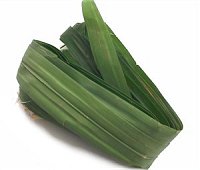 |
Pandanus Leaves (Bai
Dtoey)
Pandanus leaves are used for
wrapping up food prior to steaming
or frying, as well as giving many
Thai desserts their flavor. When you
see green colored desserts, likely
the flavor is pandanus. It’s also
common to boil the leaves and use
the tea as an additive to plain
water. In the West, you can usually
find these leaves frozen, or
sometimes you can buy ‘pandan
essence’ liquid in small bottles.
Storage: Pandanus will last a
few weeks if kept sealed in the
refrigerator. Freezing it will make
it lose a substantial amount of
flavor.
|
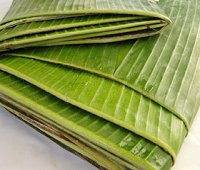 |
Banana Leaves (Bai Dtong)
The leaves of the Banana tree are
used in Thai cuisine to wrap foods
before steaming. The leaf gives the
food a slight flavor. They are never
eaten, just used as a flavoring.
They are also commonly used as
tablecloths at markets! If you live
somewhere where there are no Banana
trees to steal leaves from, you can
usually buy them frozen in bags at
Asian groceries. A common
misconception is that they have a
banana smell, they do not - they
smell like leaves! The reason we use
them is not for the smell, but
because they are waxy, so food is
easy to remove from the leaves.
Storage: Banana leaves can
be kept in the refrigerator for a
few weeks. For long term storage,
you can freeze them sealed.
|
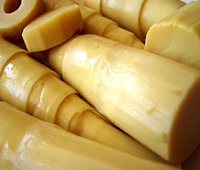 |
Bamboo Shoots (Naw my)
There are two types of
bamboo commonly used in
Thai cooking, bamboo
shoots in water and
pickled bamboo slices in
vinegar. Either way the
only part of the bamboo
that is used are the
soft shoots. Bamboo can
be bought in cans at any
Thai or Chinese grocer,
either sliced or whole.
|
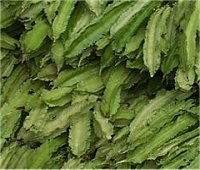 |
Wing Beans (Tua puu)
These Thai greens beans have a different appearance but a
similar taste to long green beans. If you can't find the
Thai beans use long green beans. They are eaten raw with
spicy sauce, or sometimes steamed or par-boiled.
The wing bean plant produces pea-like beans with four-winged
edges. Its lawn green pods are best picked when immature, so
that the pod and beans within can be eaten. Their flavor is
sweet like many pea varieties, with a clean grassy finish. |
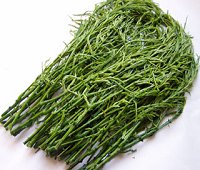 |
Cha Om
This green vegetable grows in central Thailand and is
practically a weed. It has a very strong sulfur smell,
thankfully when it's cooked the sulfur smell disappears.
It's commonly eaten cooked in omelets, and also boiled or
steamed as a dipping vegetable with spicy chili dip. Keep in
the fridge and it can last about 2 weeks, eat only the soft
tops of the stalks, not the woody lower parts. |
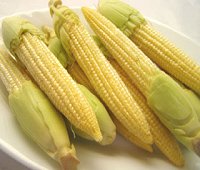 |
Baby Corn (Koa prood on)
A common ingredient worldwide, this is how baby corn is
presented in Thailand - with some of the outer husk left
attached. We eat them raw with chili paste, or steam them,
use them in soups, stir fries and many other recipes. Apart
from the presentation there is no difference between a Thai
baby sweet corn and western baby sweet corn. |
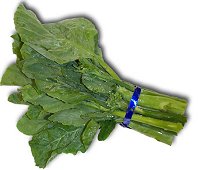 |
Chinese Kale, Chinese
Broccoli, Gai Lan (Kanah)
We eat these as a salad vegetable, like a bitter lettuce. It
is from the same family as broccoli and if you can't get
hold of them, use either broccoli leaves or a bitter
lettuce.Considered one of the world's most nutritious
vegetables, Chinese broccoli (also known as Chinese kale,
gai laarn, guy lan or kai laarn) has the highest calcium
content of any vegetables (1/2 cup cooked Chinese broccoli
has the same calcium content as 1/2 cup milk!), |
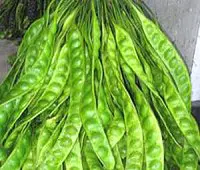 |
Sataw Beans or Stink
Beans (Saadtaw)
Sadtaw is a prized vegetable in the southern region of
Thailand. It actually is not a vegetable, but the young
beanlike seeds of a large tree, carried in long, flat and
wavy, over-sized, bright green seedpods. Each seedpod yields
only a small handful of seeds. |
 |
Peanuts (Tua li song)
Peanuts are used in a few dishes. The most
popular of which are Som Tum and Massaman Curry. It’s
easiest to purchase pre-roasted peanuts, but make sure they
are “dry-roasted” and unsalted. |
See also: Thai
Fruits
More Thai Cooking
Videos and Recipes:
|


























